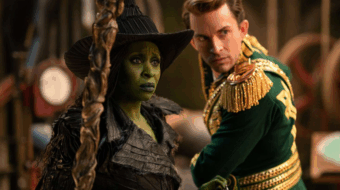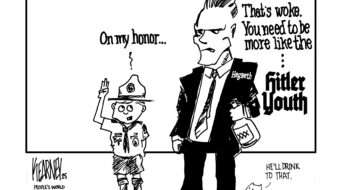
The best kind of zombie movies aren’t just about the undead roaming the Earth and eating human beings—although that can be pretty fun to watch, too. Often, ever since George A. Romero (father of the modern zombie movie) introduced the world to Night of the Living Dead in 1968, which explored social issues, bias, and fear through the lens of horror, many of the greats that have followed have done the same to remarkable effect. 28 Years Later is the latest in the zombie cinematic universe, and the third in its franchise to attempt to make its mark on audiences.
With mixed results, it somberly explores a range of themes, including coming-of-age, grief, and the breakdown (and potential rebuilding) of society. Some key emotional moments stand out, but overall, it’s a dreary movie that feels more like a setup for the next franchise installment, thus depriving cinema-goers of a full-bodied storytelling experience.
Produced and directed by Danny Boyle and written by Alex Garland, 28 Years Later is the third film in the 28 Days Later film series, following 28 Days Later (2002) and 28 Weeks Later (2007). When animal rights activists infiltrate a laboratory of scientists studying and experimenting with a highly contagious disease called the Rage Virus, they attempt to free the animals from the inhumane treatment, not knowing they’ve been infected with the Rage Virus, resulting in a rapid outbreak. It infects through blood and saliva, making those affected become zombie-like, attacking everything in a murderous fury.
Each film’s name refers to the time since the initial outbreak in which the movie takes place. By the time of the third film, the Rage Virus has been (mostly) eradicated from continental Europe, yet the British Isles remain under indefinite quarantine. A survivor colony, living on Lindisfarne—a tidal island connected to the mainland by a causeway—has grown and developed its own society. 28 Years Later focuses on a small family unit in this community consisting of Jamie, a scavenger, his wife, Isla, who has an unknown and debilitating illness, and their 12-year-old son, Spike.
Jamie takes Spike to the mainland for a coming-of-age hunting ritual, as by a certain age the youth go to the mainland to scavenge for supplies and have their first encounter with the infected, who still roam the land. What unfolds is the dangerous—and to be frank, depressing—journey of that ritual and the aftermath as secrets are revealed and Spike comes into his own. 
A significant theme in the first film was the evils that can emerge in everyday men when society breaks down. The second film, 28 Weeks Later, appeared to be a reflection on war, as many interpreted the movie as a commentary on the U.S.-led “War on Terror,” particularly the Iraq War, and the consequences of military interventions. 28 Years Later, although it has many visual allusions to the breakdown of society and how new societies can emerge for better or worse, it ultimately takes a more intimate approach.
It focuses on the interpersonal dynamics between a father and son when the son no longer idolizes the father and thus tries to define himself free from that influence. Specifically, the film unpacks how coming into masculinity and self-realization works in the brutal post-apocalyptic world that our characters find themselves in. There are times when this approach is compelling, yet something feels lost when comparisons are made to the great commentary of the first two films. Zeroing in on the coming-of-age theme doesn’t seem to carry the same heft.
Compelling performances are what carry the story, with Alfie Williams as Spike, Jodie Comer as Isla, and Aaron Taylor-Johnson as Jamie really displaying the intensity of a family unit in decay. Viewers witness the breakdown of the nuclear family under an emerging new world (dis-)order. Another highlight of the film is the all-too-short appearance of Ralph Fiennes as Dr. Ian Kelson. He plays a pivotal role but is only around for a short number of scenes with the promise of something more.
And therein lies the problem of 28 Years Later. Knowing that there is already a planned sequel entitled 28 Years Later: The Bone Temple, this film feels more like a set-up for that potential story than a complete tale that can stand on its own. We receive hints that there have been some developments in the last 28 years regarding the infected and the world’s attempts to rebuild, but those are only fleeting glimpses. That wouldn’t be too bad if the film wasn’t nearly two hours long. Spike’s growth is compelling in some parts but predictable in others. His relationship with his mother, Isla, is perhaps the most emotionally wrecking—in a good way—but it feels more like a divergence from what should have been the main plot.
There’s something to be said about a story that explores coming-of-age in a post-apocalyptic world where the systemic rules, oppressions, and privileges of yesterday no longer apply. Director Boyle hints at this with the intertwining of footage of war and battles from eras ago, from the medieval to the present. And while that technique stands out, it makes the scenes of Spike and his family feel disjointed, as the audience will no doubt wonder what’s the connection being made between those scenes. This critic wasn’t completely clear on that question, aside from perhaps concluding the message of Doyle trying to show that no matter how much society changes, war—with something or someone—always remains.
Also, the ending scene alludes to how questionable men are allowed to gain power in times of turmoil by referencing a real-life figure with a predatory and controversial history. This, though, may only be apparent to those tuned into British popular culture. Those who are not, may be left perplexed and unsettled at how different the tone of the scene feels in comparison to everything else in the film. The commentary is there, but the delivery feels muddled. And ultimately, 28 Years Later does keep with the theme of other introspective zombie movies in highlighting that there are worse things in society to fear than the undead.
Overall, 28 Years Later feels like a nice precursor to a hopefully more fully-realized sequel. It seems to lay the groundwork for it. Compelling emotional moments and a few anxiety-filled action battles with the infected make for a solid time, but as a whole, the film doesn’t hit its full potential.
We hope you appreciated this article. At People’s World, we believe news and information should be free and accessible to all, but we need your help. Our journalism is free of corporate influence and paywalls because we are totally reader-supported. Only you, our readers and supporters, make this possible. If you enjoy reading People’s World and the stories we bring you, please support our work by donating or becoming a monthly sustainer today. Thank you!










